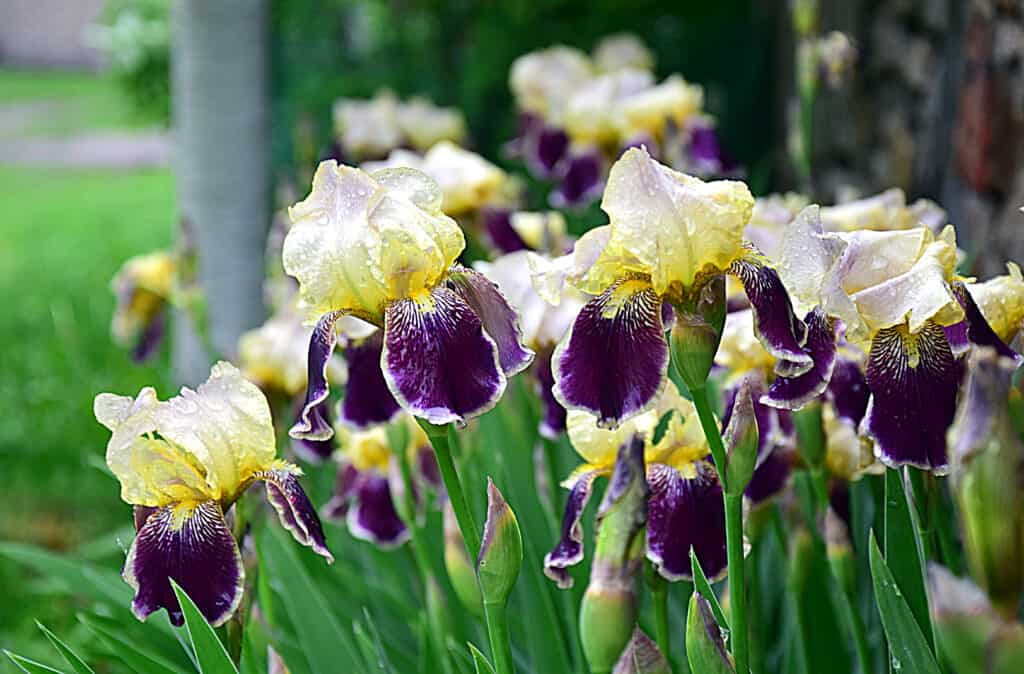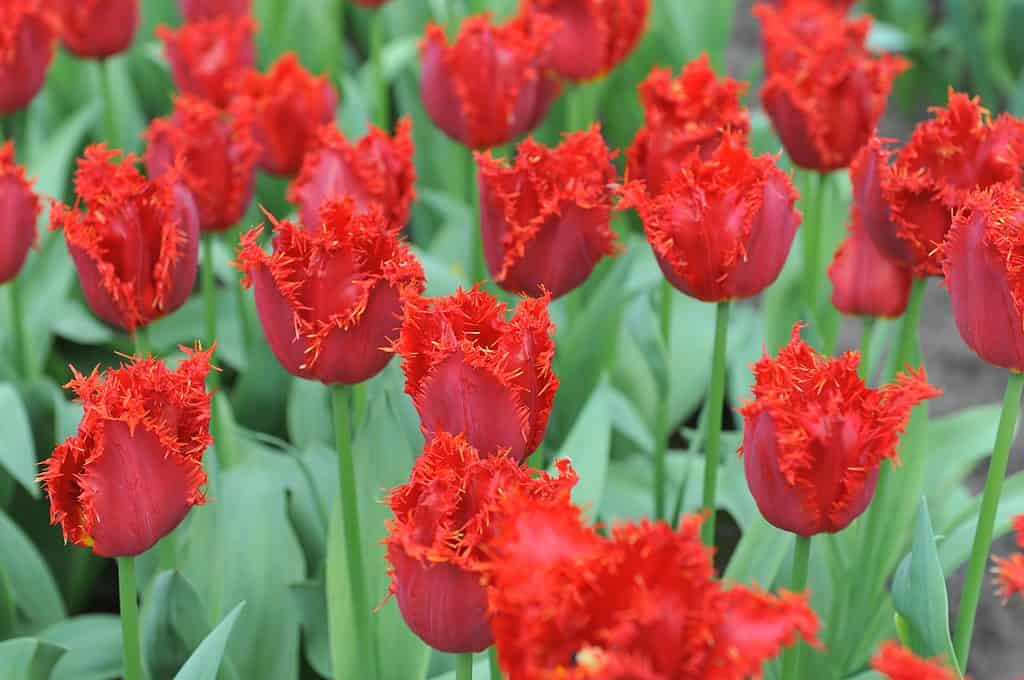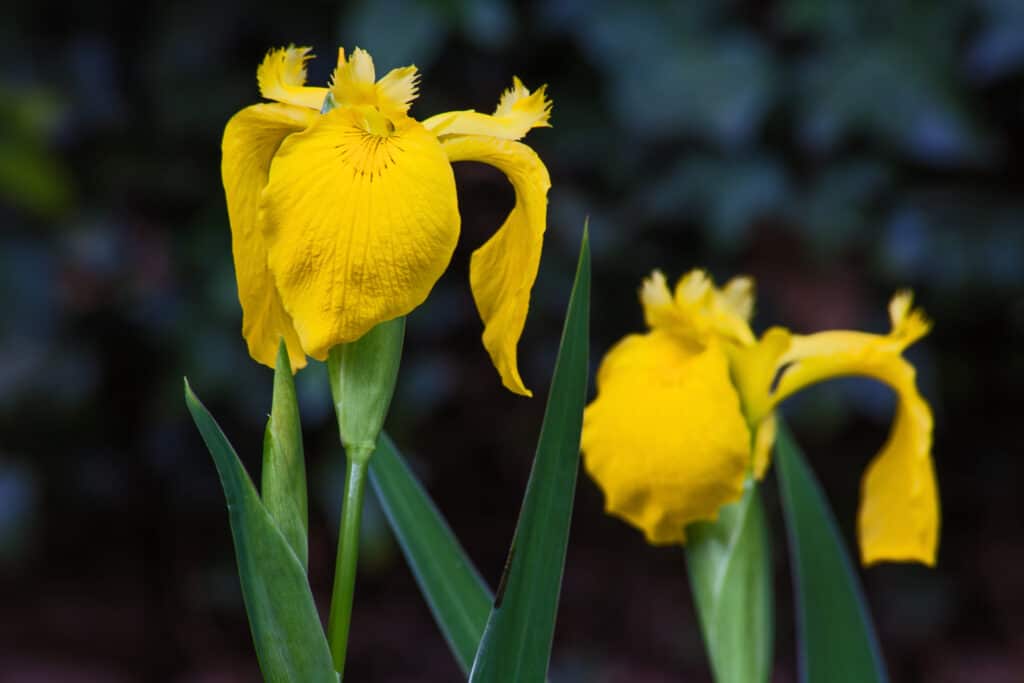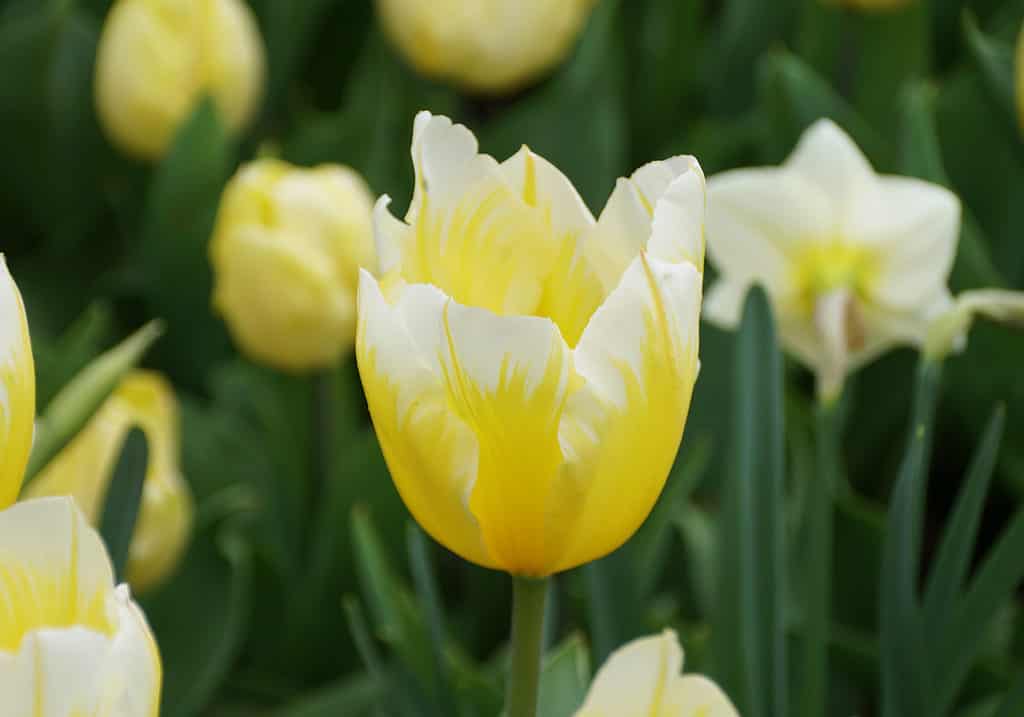Both the tulip and iris date far back in their original cultivation cultures, signifying many things, depending on the colors borne in the flowers’ petals. Both flowering plants grow from bulbs and pop up in the springtime, and both flowers are extremely popular with florists and gardeners around much of the planet.
There are pretty hefty differences, though, as the two flower families come in hugely differing assortments, belong to entirely different plant families, and have different uses and needs.

©Krzysztof Bubel/Shutterstock.com
| Tulip | Iris | |
|---|---|---|
| Classification | Tulipa, over 110 species, thousands of hybrids and cultivars | Iris or Iridaceae; 2,220 species |
| Description | Tulips come in a wide array of colors, including purple, red, pink, white, orange, mauve, and burgundy – pretty much in any color except true blue shades. The plant has 2 to 3 leaves from the stem and typically one bloom per stem. | Irises come in a huge color selection, with shades of blue, white, pink, purple, brown, red, yellow, orange, and black. They grow from bulbs and have anywhere from 2 to 10 leaves, depending on the variety. |
| Uses | Tulips are used decoratively in floral arrangements and bouquets, in artwork, in gifts, and more, but they are also herbal and culinary, used in salads and cooked dishes, and in skin care products that help deal with itchy, irritated skin. | Irises are popular as cut flowers and among flower beds, and have been used medicinally for treating a variety of ailments including dropsy. They are also fragrant and used for essential oils in aromatherapy. |
| Origins and growing preferences | Tulips were the symbol of the Ottoman Empire and presumed to have been first cultivated in Persia. The flowers became popular in Europe in the late 1500s and early 1600s. They need full sunlight and well-draining soil to thrive. | Irises date back at least as far as ancient Greece and cultivated flowers, largely used in religious and folklore contexts associated with their gods. They need at least 6 hours of direct sunlight daily, with afternoon shade in hotter climates. Plant in compost-rich soils. |
| Interesting Facts and Traits | Tulip colors each mean something different and significant: red for passion and romance, yellow for cheerfulness and happiness, white for apologies, and purple for royalty. | Iris colors symbolize different things, from purple meaning admiration for another, yellow as passion, white as purity, and blue as faith and hope. |
Key Differences Between Tulip and Iris
Tulip vs. iris – two beautiful flowers that grow in spring, welcoming the season with their vibrant colors. You’ll find there are many, many differences between the two species beyond just the names and good looks.
Tulip vs. Iris: Classification

Red Fringe tulips.
©Sergey V Kalyakin/Shutterstock.com
Botanically known as Tulipa, tulips are a flowering bulbous plant that belongs to the Liliaceae, or lily, family. The plant has about 110 varieties and thousands of variations, hybrids, and cultivars. The flowers come in variegated colors and solids.
The iris family is botanically known as Iridaceae, a flowering species that belongs to the order Asparagales. There are 66 genera and 2,220 species. Iris is the flower’s scientific name and the common name used for the whole family of flowering plants. The subgenus Scorpiris is known commonly as junos.
Tulip vs. Iris: Description

©JT Fisherman/Shutterstock.com
Tulips come in a huge range of colors, including red, white, pink, orange, yellow, cream, peach, tangerine, mauve, burgundy, almost black, purple, lime green, violet, lilac, and striped forms of these colors. Basically, tulips come in any color you can think of, except true blue. They have blue-green leaves, though, which using grow in clusters of 2 to 3 at the base of the stem.
Irises also come in a wide range of colors, including blue, white, purple, yellow, brownish red, pink, orange, black, lilac, tangerine, peach, cream, red, hazel, gray, and amber. They have either simple or branched stems that may be hollow or solid, depending on the variety, and grow between 3 and 10 basal sword-shaped leaves in clumps, or, in bulbous species, they grow 2 to 10 narrow leaves.
Tulip vs. Iris: Uses

Crested Iris flowers are considered “endangered” in Pennsylvania and Maryland.
©iStock.com/Gerald G Gantar
We plant tulips, one of the three most popular flowers in the world in traditional flower gardens, container gardens, and raised bed gardens. We grow them indoors in pots. The flowers make excellent gifts as either living plants or cut flower arrangements. Brides use them in wedding bouquets, boutonnieres, and gift baskets. Tulips are edible, as well. Chefs sometimes use them in culinary settings, replacing onions in both cooked and raw dishes. For medicinal value, manufacturers use them in skin care products and ointments to help calm insect bites, dry skin, irritations, and similar minor skin conditions.
Irises are also wildly popular flowers around the world. The beautiful array of colors and unique aesthetics and long stems make them excellent choices for bouquets, wedding flowers, floral arrangements, boutonnieres, gifts, and more. We plant irises in raised and traditional flower beds. They are less frequently found in container gardens, but they may be grown in pots as long as they can get enough direct sun. Manufacturers use them in traditional medicines. Some juice the roots to treat dropsy. Some also use the roots to “remove” freckles. The flower is fragrant, and the essential oils are often used in calming aromatherapy.
Tulip vs. Iris: Origins and Growing Preferences

The Yellow Flag Iris (Iris pseudacorus) is an easy growing plant that grows in shallow water and boggy areas. Unfortunately, it is an invasive plant, so they must be grown with caution, if even permitted in the area.
©iStock.com/kobuspeche
Tulips were the symbol of the Ottoman Empire when their cultivation began in Persia (modern-day Iran) in the 10th Century. The flowers originated in Central Asia and are part of traditions in several countries. Iran and Turkey both maintain the flower as their national flower today.
Many of us, though, connect tulips with the Dutch. In the 1500s, botanist Carolus Clusius brought the flower bulbs to the Netherlands. Raiders stole them for his established garden, birthing the tulip bulb trade and “Tulip Mania” between 1633 and 1637. During this mass craze, people bought the bulbs in large quantities, hoping to profiteer off their sales. When too many people sold at once, they crashed the market. Now, the flowers remain popular the world over and are more affordable and plentiful.
To care for tulips, plant them between 6 and 8 inches deep, with the pointed end of the bulb up. Space them 4 to 6 inches apart in well-draining soil. Keep them safe from mice and moles with the use of a wire mesh basket, if need be. Plant them where they’ll get full sun.
The iris flower dates back to ancient Greece. Placed in the religious pantheon, they honored Iris, the personification of rainbows, a goddess, and a messenger. The flower grows all over the world in many climates and is native in some unusual places like Florida swamps. Most of them are native to Europe and Asia. The flowers are largely symbolic and are emblems and representative flowers of many places. The Fleur-de-lis, for example, represents the iris and is the emblem of New Orleans. The iris is the state flower of Tennessee.
Irises prefer full sun (at least 6 hours of direct sun daily), and some afternoon shade in hotter climates for some species (Siberian and Japanese irises, for example). You grow the iris from rhizomes. Plant these in soil that has compost worked into it. Space them 1 to 3 feet apart, depending on the type, and keep them watered but not wet. If the soil is fertile, there’s no need to fertilize.
Tulip vs. Iris: Special Features and Fun Facts

Bi-color tulips are some of the most popular color forms for these stunning flowers.
©Khairil Azhar Junos/Shutterstock.com
Irises and tulips are beautiful springtime flowers that generally have the season in common and little else. They do have some fun facts, some of which even have a little overlap.
- A viral infection caused stipes on tulips, not standard “natural” causes. In 1931, though, some scientists finally discovered the source being that nasty (yet pretty!) virus. Since then, scientists have fired the aphids and have used artificial forms of the virus to alter the DNA of tulips to continue creating the striped tulips we so love.
- The history of irises traces them all the way back to ancient Greece. They planted the beautiful flowers on the graves of loved ones in the hopes of being connected to their souls in heavens, via the power of the gods. The earliest iris artwork is a fresco found in King Minos’s palace, which dates back to 2100 B.C.E., on the Isle of Crete.
- Every tulip color means something specific. Red tulips signify romantic love and passion. Yellow tulips are the sign of happiness and cheer. White tulips are the voice of an apology, and purple tulips imply royalty.
- Iris colors also mean something, with the symbol overall meaning eloquence. Purple irises indication someone’s admiration for another and signify wisdom. Yellow irises symbolize passion. Blue irises are a sign of faith and hope. And white irises represent purity.
- Tulips are intriguing flowers that have significantly longer cut flower lives than most others. This is probably for two reasons. 1. They follow the sun around, even after cut and placed in a vase. And 2. They continue growing even after they’ve been cut.
- Irises may be bearded or beardless, patterned or solid colored. A bearded iris has a fuzzy patch at the center of the petals. Beardless iris have none.
- The incredible Keukenhof, one of the largest gardens in the world, contains the largest tulip garden in the world. In April and May each spring, the garden contains over 7 million tulips. Interesting enough, though, the largest tulip festival in the world is largely considered to be the Canadian Tulip Festival, held each year in Ottawa, mid-May.
- Irises were named for the ancient Greek goddess of the rainbow of the same name. Ancient Greeks thought she traveled via way of rainbows to the Earth, carrying messages between the gods and humans. Many folks think the name came to be for this flower because of the array of colors found in irises naturally.
- Tulips have been inspiring artworks for millennia. Ancient Islamic art has many depictions of the flowers, as do more recent works across the globe in more contemporary times. There was a huge boom of tulip art in the 1600s when the flowers evoked a craze known as Tulip Mania.
- While some parts of the iris are toxic, others have been used medicinally and cosmetically. Manufactureres often use the fragrance in perfumes and juice from the iris roots in treatments to remove freckles. Some blend the roots to create topical treatments for skin conditions and used in cough syrups, and the seeds are thought to have helped with digestive issues.
The photo featured at the top of this post is ©
Thank you for reading! Have some feedback for us? Contact the AZ Animals editorial team.






